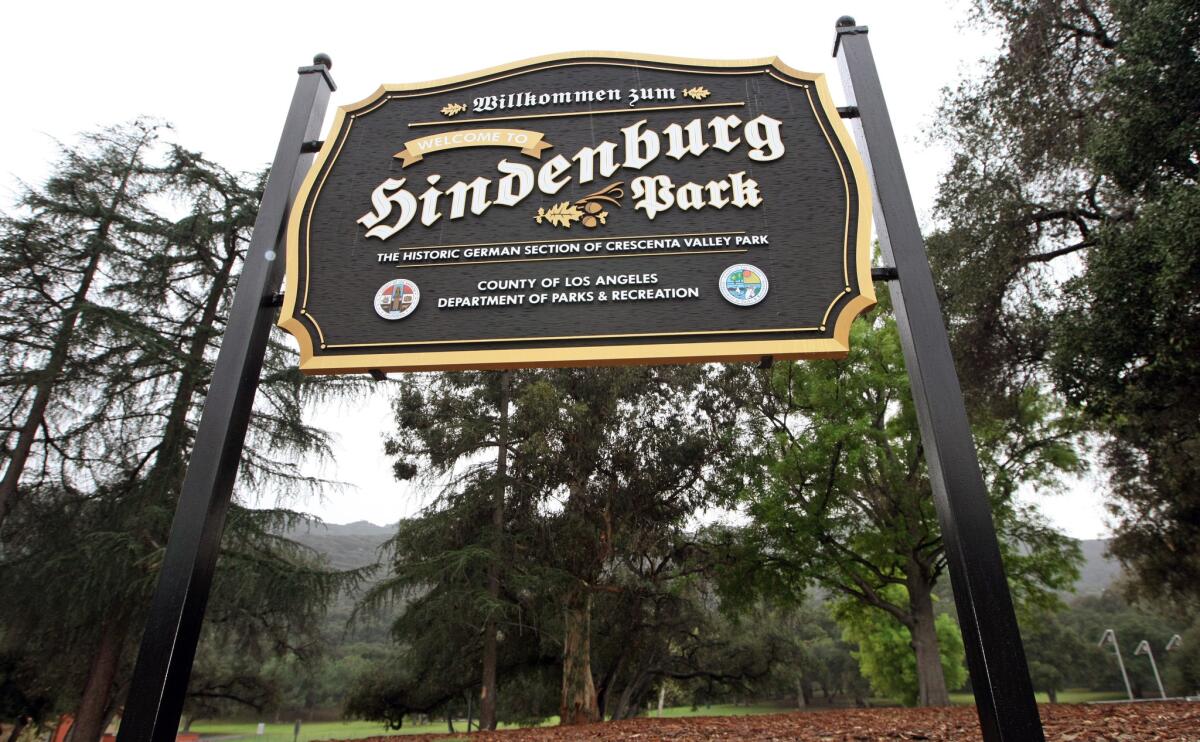County commissioners hear from both sides in debate over Hindenburg Park sign

In February, Los Angeles County put up a sign for Hindenburg Park, which has been at the west end of Crescenta Valley Park since it was purchased by the county in 1958. The sign was paid for the Tri-Centennial Foundation, a German heritage organization.
- Share via
A public hearing was held Thursday regarding a new sign at Crescenta Valley Park, with its supporters saying it preserves local German history, and opponents claiming it’s offensive because it pays tribute to a past German president who some argue paved the way for Adolf Hitler’s rise to power.
More than 100 people crowded inside the Sparr Heights Community Center to make their case about the sign, which welcomes visitors to Hindenburg Park, located in part of Crescenta Valley Park.
NEWSLETTER: Stay up to date with what’s going on in your community>>
Three members of L.A. County’s Human Relations Commission heard arguments to either keep the sign or remove it. The commissioners will report back to the full board, which will make a decision during a future meeting.
The park is named after Paul Von Hindenburg, who is considered a World War I hero and served as Germany’s president from 1925 to 1934.
The German heritage group Tri-Centennial Foundation paid for the sign and its installation as a way of commemorating the German population in the Crescenta Valley dating back to the 1920s.
The site was acquired back then by the German American League and was the site of the first Oktoberfest celebration in Southern California in 1956.
The county’s parks department in 1992 dedicated a section of Crescenta Valley Park as Hindenburg Park.
Join the conversation on Facebook >>
Supporters of the sign say it’s a tribute to the celebration of German culture there during the first half of the 20th century.
However, the site was also known for Nazi rallies, and Jewish community leaders argue the sign hearkens back to the Holocaust and the reign of Nazism.
Jason Moss, executive director of the Jewish Federation of the Greater San Gabriel and Pomona Valleys, told commissioners that Hindenburg appointed Hitler as Germany’s chancellor in 1933.
“The fact remains, it was his decision,” he said. “The name Hindenburg will always be tied to this, and this sign’s presence is a reminder.”
Moss said he’s not against the Tri-Centennial Foundation in its efforts to pay tribute to history, but it would be fair to put up another marker that informs visitors that Hindenburg Park was also a gathering place for Nazis.
“The Jewish Federation supports the German-American community celebrating its heritage, but it’s also important to understand that the sign they have erected should be a reminder of all the events that took place at the park, not just the happy ones,” he said.
Defenders of Hindenburg said he was a revered figure, who detested the Nazis and Hitler. Some believe Hindenburg was pressured into making Hitler’s appointment.
“The park was originally named for [Hindenburg], not for what came after he died,” said Carole Brennan, who sits on the board of directors of the German-American League of Los Angeles.
Stuart Biles, acting president of the Crescenta Valley Historical Society shared similar sentiments and criticized the opponents of the Hindenburg sign, calling them “ignorant.”
“We are not in favor of outside groups coming to tell us in our valley how we shall remember our history,” he said.
For others, however, there was also concern that the sign may be confusing.
Resident Mona Field said those entering the park at the Dunsmore Avenue entrance may see the sign and believe Crescenta Valley Park is actually called Hindenburg Park.
“[The sign] is quite misleading,” she said. “It’s really inappropriate to have that large sign as the only sign at that entrance.”
--
Arin Mikailian, [email protected]
Twitter: @ArinMikailian
